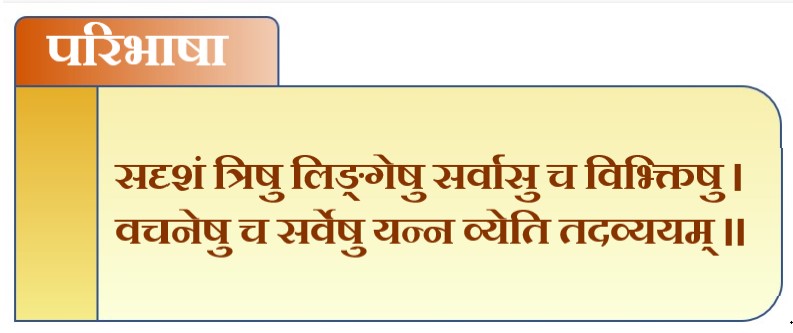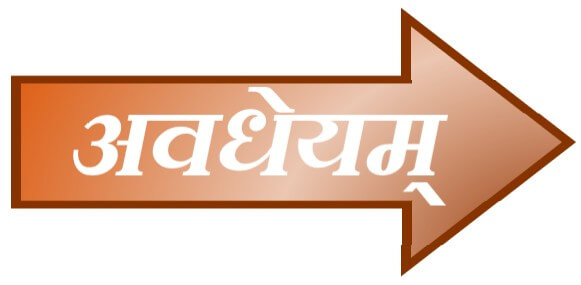 | We learn about........ | |
| We have so far learned in this module... |
|
| The goal of this lesson is to learn ….. |
|
Please click the heading to view the Sambashana video chosen for this lesson. In the video,
We list the sentences which were made in the class room video.
| Conversation Practice - सम्भाषणाभ्यासः | |
|---|---|
| अद्यतन-गृहपाठं लिखितवान् वा? Did you write the home work for today? | अद्यतन-बालकाः एव श्वस्तन-पौराः। Today’s children are indeed tomorrow’s citizens. |
| श्वस्तन-कार्यम् अद्य एव चिन्तयतु। Plan today itself for tomorrow’s work. | ह्यस्तन-पत्रिकां पठितवान् वा? ह्यस्तन-गृहपाठं लिखितवती वा? ह्यस्तन-पाठं न पठितवती। |
| अद्यतन-अल्पाहारे मिष्टान्नं भवतु। Let there be sweet in today’s breakfast. | भारतदेशस्य पूर्वतन-नाम आर्यावर्तः। The earlier name of Bharata Desa was Aryavartha. |
| लाल् बहादूर शास्त्री भारतदेशस्य पूर्वतन-प्रधान-मन्त्री। Lal Bahadur Sastri is Bharata Desa’s former prime minister. | विवेकानन्दस्य पूर्वतन-नाम नरेन्द्रः.। The earlier name of Vivekandanda was Narendra. |
| इदानीम्तन-बालाः बहु चतुराः सन्ति। Nowadays children are clever. | इदानीम्तन-युवकाः परिश्रमं न कुर्वन्ति। Youth of today do not work hard |
| इदानीम्तन-महिलाः सर्वेषु क्षेत्रेषु कार्यानि कुर्वन्ति। Women work in all fields in these times. | इदानीम्तन-कार्यालये सङ्गणकानि सन्ति। In these times computers are there in Offices. |
| पूर्वतनकाले यन्त्रस्य उपयोगः अधिकः नासित्। In earlier times machines were not used much. | इदानीम्तनकाले सर्वे यन्त्रस्य उपयोगं कुर्वन्ति। Nowadays, machines are used everywhere. |
| अद्य अहम् अत्र अस्मि। गत-दिने मैसूरु नगरे आसम्। | गत-सप्ताहे मम परीक्षा आसीत्। गतमासे मम कन्याः विवाहः आसीत्। |
| गतवर्षे मम सहोदरः विदेशं गतवान्। गतसप्ताहे मम सख्याः जन्मदिनम् आसित्. | आगामि-सप्ताहे मम जन्मदिनं भविष्यति। आगामिमासे दीपावली भविष्यति। |
We have come across many अव्ययानि पदानि in our earlier lessons and the conversation videos we watched. Padam (पदम्) as defined by ऋषिः पाणिनिः consists of only two forms. ‘सुप्तिङन्तं पदम्’ (1.4.14). That is words formed by the union of ‘सुप्’ or ‘तिङ्’ प्रत्ययाः with roots (धातुः / प्रातिपदिकम्) qualify to be called as Padams. These two types are popularly known as क्रियापदानि and नामपदानि. When the ‘सुप्’ प्रत्ययाः’ joined to base nouns (प्रातिपदिकानि) are dropped in the process Avyayani are resulted. And hence they also get the ‘पदम्’ designation (संज्ञा). These Avyaya words retain the same form in all Vibhakthis, Lingas and Vachanas.
Indelcinables in Samskritam are ‘सुबन्तपदानि’ formed by dropping the ‘सुप्’ प्रत्ययः. They remain the same in all Case endings, gender and Number.


Avyayas are many in number. We give a general classification of अव्ययानि along with few examples for each type. We also read few example sentences for most commonly used Avyayas to understand their usage.
Adverbs (क्रियाविशेषणानि) which describe the action are अव्ययानि. We list few commonly used क्रियाविशेषणानि and also tell about the aspect of क्रिया they qualify. When we learn passages in next module, we will come across Avyayas of this type and you can easily understand their role in the sentence.
| अव्ययम् | English Meaning | प्रकारः |
|---|---|---|
| अद्य, श्वः, ह्यः इत्यादयः | We have learned this type of Avyayas in earlier lessons. | कालवाचकानि |
| प्रातः, सायम् | Morning, Evening | कालवाचके |
| अधुना, इदानीम्, सम्प्रति | Now, nowadays | कालवाचकानि |
| सदा, सर्वदा | Always | कालवाचके |
| एकदा | Once, at one time | कालवाचकम् |
| कदाचित् | At sometime | कालवाचकम् |
| तदा | Then | कालवाचकम् |
| यदा.......तदा | When…….. then | कालवाचके, सम्बन्ध-बोधके |
| अत्र, तत्र, सर्वत्र, अन्तः, बहिः, अग्रे, पुरतः, परितः | We have learned this types of Avyayas in earlier lessons. | स्थानवाचकानि |
| यत्र.......तत्र | Where…….there | स्थानवाचके, सम्बन्ध-बोधके |
| उच्चैः | Loudly | रीतिवाचकम् |
| शनैः | Softly, slowly | रीतिवाचकम् |
| पुनः, भूयः | Again | रीतिवाचके |
| शीघ्रम् | Quickly,fast | रीतिवाचकम् |
| मन्दम् | Slowly | रीतिवाचकम् |
| सम्यक् | Well | रीतिवाचकम् |
| तथा | That way | रीतिवाचकम् |
| यथा.......तथा | As…….so | रीतिवाचके, सम्बन्ध-बोधके |
| इत्थम्, एवम् | Like this | रीतिवाचके |
| किञ्चित्, ईषत् | Little | परिमाणवाचके |
| केवलम् | Only | परिमाणवाचकम् |
| तावत् | That much | परिमाणवाचकम् |
| यावत्.......तावत् | As much…….that much | रीतिवाचके, सम्बन्ध-बोधके |
| किम्, कदा, कुत्र, किमर्थम्, कथम्, कुतः | Questions | प्रश्नवाचकानि |
कालवाचक, स्थानवाचक, रीतिवाचक and परिमाणवाचक Avyayas are got as answer to questions asked using कदा, कुत्र/कुतः, कथम् and कियत् respectively.
We come across this type of Avyayas very often. We list a few of them here.
| अव्ययपदम् | Meaning |
|---|---|
| च / तथा | And |
| अपि | Also |
| अतः | Therefore |
| यतः | Because |
| परन्तु / किन्तु | But |
| यदि / चेत् | If |
| तर्हि | Then |
There are other Avyayas like ‘तु’, ‘हि’ used as Interjections or just fillers in sentences. Let us now look at the example sentence for some of the Avyaya padas listed above. The avyayas are highlighted in yellow background.
| शशकः शीघ्रम् गच्छति। | Rabbit goes fast. |
| कूर्मः मन्दम् गच्छति। कूर्मः शनैः गच्छति। | Turtle goes slow. |
| शिशुः उच्चैः रोदिति। | Baby cries loudly. |
| कृपया शनैः वदतु। | Please talk quietly. |
| बालिका सम्यक् गायति। | Girl sings well. |
| रामः गच्छति। लक्ष्मणः गच्छति। रामः लक्ष्मणः च गच्छतः। | Rama and Lakshmana go. |
| प्रार्थना-समये..... अध्यापकाः आसन्। अध्यापिकाः आसन्। छात्राः आसन्। प्रार्थना-समये अध्यापकाः, अध्यापिकाः छात्राः च आसन्। | Teachers (male and female) and students were present at prayer time. |
| च → And | |
| रामलक्ष्मणेभ्यः सह सीता अपि वनम् अगच्छत्। | Sita also went to forest with Rama and Lakshmana. |
| मम पुत्रस्य अपि नाम गिरीशः। | The name of my son is also Girish. |
| अपि → Also | |
| बालिकाभ्यः एव पाञ्चालिका रोचते, न तरुणीभ्यः। | Only little girls like Dolls, not young girls. |
| संस्कृतवर्गे संस्कृतेन एव सम्भाषणं कुर्मः। | We talk only in Samskritam in Samskritam class. |
| एव → Only | |
Avyaya ‘च’ meaning ‘and’ in English is used to give the sense of collection or group. In contrast to English sentences ‘च’ is joined at the end.
Rama and Krishna → रामः कृष्णः च
‘अपि’ is used with words in all seven Vibhakthis.
’एव’ is used to stress something (निश्चयः). ‘एव’ stresses one thing and eliminates the rest.
Repeating or quoting other’s expression is relatively easy in संस्कृतम्. The task is achieved using Avyayas ‘इति’ or ‘यत्’.
अव्ययम् ‘इति’ follows the referred sentence in a Quote.
उदाहरणम्
“सत्यं वद” इति उपनिषद् वदति।
“इदानीं मम धनम् आवश्यकम” इति रमेशः उक्तवान्।
Same goal can be achieved using ‘यत्’. But there is a slight change in the usage.
The quote follows अव्ययम् ‘यत्’ when referred without quote marks “”.
उदाहरणम्
“अधिकारी अवदत् यत् विलम्बेन कार्यालयम् न आगच्छतु।"
भगवान् श्रीकृष्णः अर्जुनम् उक्तवान् यत् सर्वधर्मान् परित्यज्य मामेकं शरणं व्रज.

While quoting use either ‘इति’ or ‘यत्’. Do not use both. उभयं मा प्रयुज्यतु।
‘अहं न जानामि’ इति राधा उक्तवती। - 
राधा उक्तवती यत् अहं न जानामि। - 
राधा उक्तवती यत् अहं न जानामि इति – 
Therefore and because are two conjunctions in English which relate two sentences with reason. संस्कृत-भाषायाम् एतत् कार्यं अतः, यतः इति अव्ययद्वयेन सिद्ध्यते. Same job is achieved in संस्कृतम् using Avyayas अतः and यतः.
| कारण-वाक्यम् | कार्यवाक्यम् |
|---|---|
| विद्युत् नास्ति। | दीपः न ज्वलति। |
| एकम् वाक्यम - विद्युत् नास्ति, अतः दीपः न ज्वलति। | |
| लोकयानं न प्राप्तम्। | विलम्बेन आगतवान्। |
| एकम् वाक्यम - लोकयानं न प्राप्तम्, अतः विलम्बेन आगतवान्। | |
Avyaya ‘अतः’ join two sentences, कार्यवाक्यम् and कारण-वाक्यम् into one. In the sentence formed, ‘अतः’ joins कार्यवाक्यम् and follows कारण-वाक्यम्.
The same sentences can be joined using ‘यतः’ as follows:
| कारण-वाक्यम् | कार्यवाक्यम् |
|---|---|
| विद्युत् नास्ति। | दीपः न ज्वलति। |
| एकम् वाक्यम - दीपः न ज्वलति, यतः विद्युत् नास्ति। | |
| लोकयानं न प्राप्तम्। | विलम्बेन आगतवान्। |
| एकम् वाक्यम - विलम्बेन आगतवान्, यतः लोकयानम् न प्राप्तम्। | |
Avyaya ‘यतः’ join two sentences, कार्यवाक्यम् and कारण-वाक्यम् into one. In the sentence formed, ‘यतः’ joins कारण-वाक्यम् and follows कार्यवाक्यम्. That is the order present in the sentence with ‘अतः’ is reversed in the sentence with ‘अतः’.
We have already learned the forms obtained when कृत् Pratyayas like ‘क्तवा / ल्यप’ and ‘तुमुन्’ join धातवः. Although they indicate actions, they are प्रातिपदिकानि as the result from the join of धातुः and कृत्-प्रत्ययः. They remain as Avyayas by joining with Vibhakthi Pratyayas. Please click the links to the lessons to revise their forms and usage.
क्त्वा/ल्यप्-प्रत्ययान्तस्य प्रयोग
तुमुन् प्रयोगः
The list of 22 उपसर्गाः technically known as प्रादयः also get designated as अव्यय-पदानि। Click to check the lesson on उपसर्गाः and brush up your knowledge on उपसर्गाः(Prefixes).
The scope of this lesson is to give an idea on अव्ययपदानि and list a few of them with example sentences. We will come to know about more Avyayas as we read more Samskritam Texts. We now complete this compact lesson on Avyayas with our usual practice exercises. आगच्छन्तु। अव्यय-सम्बन्धितम् अभ्यासं कुर्म।
| एव प्रातः मन्दम् च गन्तुम् अपि उच्चैः बहिः इति गत्वा यतः यत् अतः मा सम्यक् |
We welcome your views and suggestions on this lesson. Please post your comments and replies after registering free. Please also send a mail to samskrit@samskritaveethy.com for any clarification on the lesson.
We have so far learned....
In this module on संस्कृत-नामपदानि क्रियापदानि च, we got a primary knowledge on नामपदानि क्रियापदानि, अव्ययानि च. We learn little bit more about numbers (सङ्ख्याः) before we conclude this module. Our next lesson is….
Lesson 25: More on Samskrit Number Forms - सङ्ख्या - किञ्चित् अधिकं पठनम्
 | 0 comments |
To get updates on
संस्कृतवीथी...